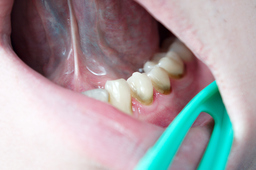Biodegradable Periodontal Tissue Engineering Membrane with Thermosensitive Clinical Handling Properties
TECHNOLOGY NUMBER: 2022-212

OVERVIEW
A novel thermosensitive membrane for use in surgery for periodontal disease- Progresses from more rigid to increasingly flexible with rising temperatures
- A protective, exclusionary external matrix paired with a regenerative matrix facing the deficit
BACKGROUND
Chronic periodontal disease affects about 40% of adults in the United States. Regenerative periodontal surgeries are recommended in severe cases when the bone that supports the teeth has been damaged or destroyed. These surgeries frequently use artificial membranes that prevent the more rapidly growing epithelial cells from filling in the area of more slowly growing bone cells and crowding them out. The membranes must be biocompatible, non-allergenic, easy to use in the clinic, able to maintain their shape, and durable over the time frame required for bone regeneration. Unfortunately, existing membranes are not easily sutured into, they do not permit controlled dosing of growth factors, and they usually require a tradeoff in mechanical properties between rigid or elastic. As such, a need exists for membrane technologies that fulfill a more robust set of clinical requirements.
INNOVATION
Researchers at the University of Michigan have developed a thermosensitive membrane for regenerative periodontal surgery. The membrane is made from an interpenetrating network of poly L-lactic acid (PLLA) and polycaprolactone (PCL) and allows for promotion of tissue regeneration while exhibiting a flexible structure capable of fitting any required space. The properties of the device can be modulated by warm water, progressing from rigid to more flexible with increasing temperature. Its temperature-sensitive mechanical properties foster increased flexibility for clinical handling and fitting without loss of its intrinsic nanostructure that promotes regeneration. The membrane is fabricated with a bilayer topology such that an exclusionary external matrix faces outward and provides protection while a regenerative matrix faces the defect and promotes tissue regrowth. The membrane structure can also be loaded with nanoparticles to provide controlled release of small molecules and peptides to further induce regeneration. The invention addresses many of the shortcomings of conventional membranes for periodontal disease surgery.